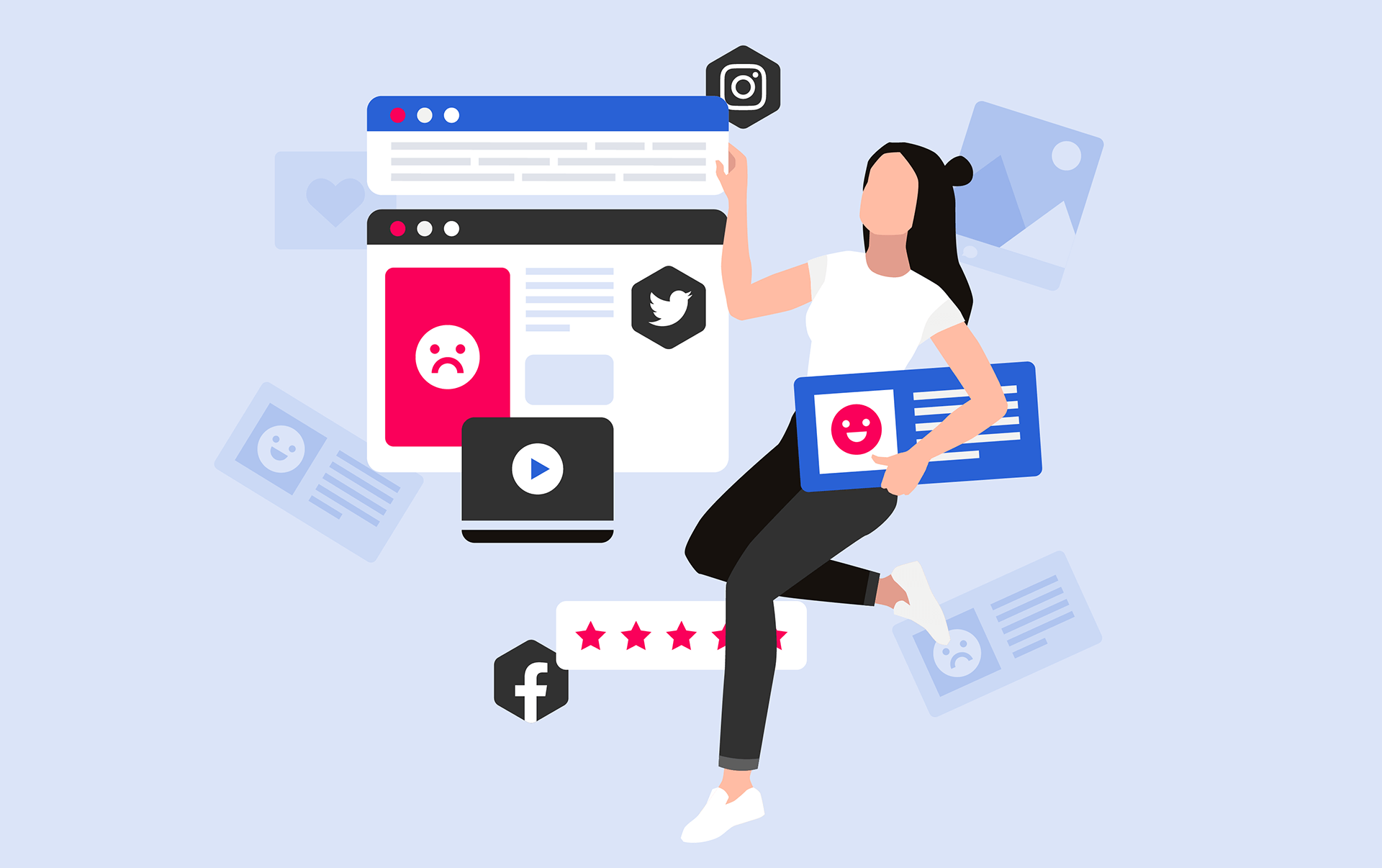Influencer UGC marketing is where social media serves up endless inspiration. For instance, you spot a mouthwatering recipe on Instagram, give it a try, and proudly share your culinary triumph with your followers. What you may not realize is that you’re dipping your toes into the world of user-generated content (UGC), where everyone brings something unique to the digital table, turning everyday moments into shared experiences.
In our Shopper Experience Index, a study exploring how shoppers behave, we found that a significant 55% of people are unlikely to buy a product if it lacks user-generated content like reviews and customer photos.
Discover the power of integrating user-generated content into your marketing strategy. It’s all about building authenticity, boosting sales, and fitting into today’s creator-focused economy. These elements are essential for thriving in today’s competitive market.
Let’s understand the definition of UGC in this article, its importance, types, and some of the best tips.
Table of Contents
What is Influencer UGC Marketing on Social Media?
User-generated content (UGC) in social media marketing refers to content made and shared by regular people who love a brand, not by the brand itself. UGC can be anything from customer reviews to photos and videos shared on social media about a brand or its products.
For example, when someone posts a picture of their delicious latte on Instagram and talks about how much they love it, that’s UGC. In short, UGC is authentic content created by fans and shared on social media or other platforms.
Why is UGC Important?
User-generated content (UGC) is crucial because it helps brands connect with customers and boost sales. Whether it’s on social media, emails, or websites, UGC influences people’s decisions every step of the way.
In today’s crowded online world, standing out is hard. But UGC, like posts from happy customers, builds trust. Most people trust what real customers say over ads or influencers.
But, don’t try to fake it. People can tell when something’s not real, and that can hurt your brand. Stick to content from your customers, loyal fans, or employees.
Think of Influencer UGC marketing as modern-day word-of-mouth. People trust recommendations more than ads. Sharing UGC makes people feel like they’re part of something special, which boosts loyalty. It also helps brands build better relationships with customers, keeping them coming back for more.
Social proof is essential because it helps build trust in brands. That’s why people don’t trust ads or marketers anymore. Only about a third of Americans trust the media, which is a record low. To win people’s trust, brands need to show they’re reliable. Social proof is a trick that makes people want what others enjoy. User-generated content (UGC) is a perfect example. When people see others happy with a product, they’re more likely to try it.
You can use UGC in emails or on websites, not just social media. For instance, putting UGC photos in emails can persuade customers to buy. Calvin Klein even made a page just for UGC to show off how real people wear their clothes.
Saving money is important for any business. Hiring influencers can cost a lot, but asking your customers to share posts about your product? That’s almost free. User-generated content (UGC) is a smart way to grow your business without spending much. You can reach more people and have different kinds of content without paying a fortune to ad agencies or for big campaigns.
With UGC, you get to connect directly with your customers, which is pretty cool. Most of them would be happy to see themselves on your page. Especially for small brands or those just starting out, UGC is a great way to get the word out without breaking the bank.
Why User-Generated Content is Good For Your Brand?
User-generated content (UGC) does wonders for your brand. Here’s why:
If you’re stuck for content ideas, UGC is your answer. It’s like having a treasure trove of customer posts, reviews, and stories at your fingertips. Plus, staying active on social media keeps your brand in the spotlight, as most consumers follow brands to learn about new things.
Influencer UGC marketing turns your customers into trustworthy advocates for your brand. When potential buyers see real people enjoying your product, it’s like getting a recommendation from a friend. This social proof nudges them towards making a purchase. And guess what? Many people find UGC more engaging than other types of content in their social feeds.
Every share, tag, or mention of your brand in UGC introduces you to new audiences. It’s like a chain reaction where each post reaches more people, thanks to the trust people have in their friends’ recommendations.
Unlike paid ads, UGC feels genuine because it’s created by real people, not actors. Brands that embrace UGC bridge the gap between promotional and authentic content, building trust along the way.
When you feature UGC, you’re showing appreciation for your customers. This strengthens their bond with your brand, making them more likely to stick around and even advocate for you. Remember, loyal customers are your best asset in building brand loyalty.

Types of Influencer UGC Marketing
There are many types of user-generated content (UGC) that customers can create to showcase your brand:
Customer Reviews and Testimonials: Customers share their thoughts and love for your brand through posts and stories. For example, Trello reposted a tweet from Tony Lango, an Engagement Relationship Manager, giving a personal endorsement on platforms like Instagram and X.
Photos: Customers take pictures of your brand or products, adding credibility and social proof. Gymshark’s Instagram feed features fitness influencers wearing their activewear, showing the products in action and highlighting loyalty.
Videos: Your audience creates videos using your product, acting as digital word-of-mouth. For instance, Benefit reposted a TikTok from makeup artist Colleen showcasing Halloween makeup using Benefit’s products, demonstrating product usage and customer creativity.
Blogs: Sometimes, customers write detailed experiences or stories about your products on their blogs. Hostinger featured Grammarly as the best grammar assistant in a roundup article, which Grammarly could then share or collaborate on for future content.
Comments: Comments provide valuable opinions and insights. Glassdoor created a Facebook post from responses in its Interview Tips Bowl series, showing engagement with the brand and offering audience insights.
How is Influencer UGC marketing Different From Regular Influencer Marketing?
User-generated content (UGC) and influencer marketing are two distinct but related strategies in digital marketing. Influencer UGC marketing refers to content created and shared by regular consumers who are fans or users of a brand. This content is unsolicited and arises directly from customers, fans, or employees. It is perceived as highly authentic because it reflects the genuine experiences and opinions of real users of the brand. UGC encompasses a wide range of content types, including reviews, photos, videos, testimonials, and comments, shared on various platforms.
In contrast, influencer marketing involves collaborating with individuals known as influencers, who have significant followings on social media platforms. These influencers are typically contracted or briefed to create and share content promoting a brand or its products/services. Influencer marketing provides brands with more control over the content creation process, as influencers may receive compensation or incentives and are often guided by specific messaging and brand guidelines.
While both UGC and influencer marketing utilize user-generated content for promotional purposes, they differ in terms of authenticity and control. UGC is highly authentic, reflecting the genuine sentiments of real customers, while influencer marketing may be perceived as less authentic due to influencers receiving compensation or incentives. Brands have limited control over UGC, as it arises organically from consumers, whereas they have more control over influencer marketing content through contractual agreements and briefing processes.
Despite these differences, both influencer UGC marketing and influencer marketing play valuable roles in digital marketing strategies, utilizing the power of user-generated content to engage audiences and promote brands effectively.
Why is Influencer UGC Marketing Suddenly a Buzzword?
User-generated content (UGC) has become a buzzword in recent years due to several factors:
With the rise of social media and online platforms, consumers are increasingly active in creating and sharing content. UGC reflects authentic experiences and opinions from real users, making it more relatable and trustworthy than traditional advertising.
Social media platforms have democratized content creation, giving ordinary individuals the power to share their thoughts, experiences, and creations with a global audience. Brands recognize the potential of tapping into this vast pool of user-generated content to connect with consumers on a deeper level.
In an age of information overload and skepticism towards traditional advertising, authenticity has become a key driver of consumer trust and loyalty. Influencer UGC marketing offers brands an opportunity to showcase genuine interactions and endorsements from real customers, thereby building credibility and trust.
Studies have shown that influencer UGC marketing can significantly impact consumer behavior, influencing purchasing decisions and driving engagement. Consumers are more likely to trust recommendations from their peers than from brands or influencers, making UGC a powerful tool for brands to leverage in their marketing strategies.
Technological advancements have made it easier for brands to collect, curate, and leverage UGC in their marketing efforts. From social media listening tools to UGC platforms, brands now have access to a wide range of tools and resources to harness the power of user-generated content.
Overall, the rise of influencer UGC marketing as a buzzword reflects its growing importance and effectiveness in modern marketing strategies, as brands strive to engage with consumers in more authentic and meaningful ways.
7 Tips For Cost-Effective Influencer UGC Marketing
User-generated content (UGC) is a bit different from other types of content marketing because you don’t have full control over what people create. But don’t worry, you can still use some smart strategies to guide the content and make the most of it.
- Find out where your target audience spends their time online. Then, encourage them to share content on those platforms. For example, if you’re targeting creative types, Instagram and TikTok might be the best places to focus.
- Decide what you want to achieve with your UGC campaign. Do you want to increase brand awareness or drive more traffic to your website? Setting clear goals will help you plan your strategy and measure your success.
- Don’t be too strict with your guidelines. Give people the freedom to express themselves in their own way. This will help you get more authentic content from a diverse range of perspectives.
- Encourage content that aligns with your brand values and story. This will make it more appealing to your target audience and keep your messaging consistent across all your marketing efforts.
- If someone creates content about your brand without you asking, always get their permission before reposting it. This shows respect for their work and helps you avoid any legal issues.
- Use monitoring tools to keep track of what people are saying about your brand online. This will help you identify opportunities for engagement and collaboration.
- Regularly analyze the performance of your UGC campaigns to see what’s working and what’s not. Use this information to refine your strategy and make improvements over time.
By following these tips, you can make the most of user-generated content and use it to effectively promote your brand without breaking the bank.
Influencer UGC marketing offers a powerful avenue for brands to connect with their audience in an authentic and engaging way. By utilizing user-generated content from influencers and regular consumers alike, brands can build trust, boost brand awareness, and drive conversions cost-effectively. By prioritizing relevant platforms, setting clear goals, encouraging creativity, and monitoring performance, brands can harness the potential of influencer UGC marketing to create meaningful connections with their audience and achieve their marketing objectives. With the right strategies in place, influencer UGC marketing presents an invaluable opportunity for brands to thrive in today’s competitive digital landscape.
Share your thoughts and experiences with us in the comments below! We’d love to hear how you’re using user-generated content to connect with your audience and drive results. Let’s start a conversation and learn from each other’s successes and challenges. Your insights could inspire others to take their marketing efforts to the next level. Join the discussion now!

















